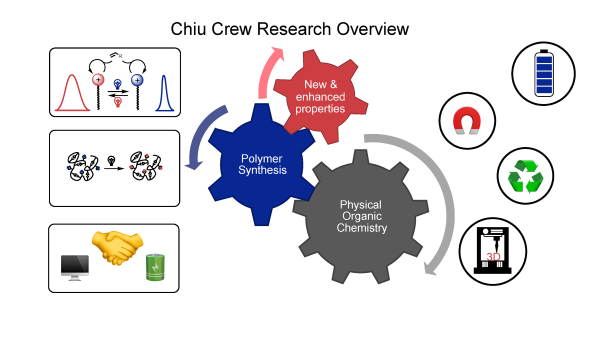Melanie Chiu

Research
Physical Organic Approaches to Polymer Synthesis
(Research Description PDF)
What makes a material hard vs. soft; conductive vs. insulating; degradable vs. persistent? How do the molecular features of a polymeric material affect its physical properties and performance? How can we harness the tools of synthetic chemistry and our understanding of chemical reactivity to tailor the properties of polymeric materials? Driven by these overarching questions, researchers in the Chiu group will gain expertise in molecular synthesis and studying chemical reactivity in a collaborative environment that embraces organic chemistry, polymer chemistry, and materials science and engineering.
Remarkable innovations over the past few decades in controlled polymerization techniques and post-polymerization functionalization have enabled access to myriad well-defined polymer structures incorporating a broad range of functional groups. Building on these important, ongoing advances, a vigorously growing area of interest in polymer chemistry is the development and study of polymerization systems that can be modulated by external stimuli. Among several intriguing external stimuli, we are particularly interested in the use of light as a tool in polymer synthesis because it is orthogonal to many of the functional groups we seek to manipulate chemically and also because so many parameters of illumination can be tuned and automated by modern optics: timing, location, wavelength, and intensity.
Taking advantage of these features, one project features the design, synthesis, and evaluation of photochromic polymerization agents that enable us to tune polymer molecular weight distribution using light. We seek to expand this concept to the photomodulation of polymer tacticity and copolymer sequence. We expect these methods to find application and impacts in advanced manufacturing techniques, like 3D printing, as well as in the quest to develop more sustainable and degradable plastics.
Another focus in the group that utilizes light as a synthetic tool is the development of photoactivated single-chain polymer nanoparticles (SCNPs). SCNPs are polymer chains that undergo intramolecular cross-linking, similar to the folding of a peptide into a protein with tertiary structure. In addition to the biomedical applications of these species (e.g. drug delivery), SCNPs have demonstrated promise as catalysts. A challenge in this area is the incorporation of unsaturated, catalytically active metal species into SCNPs. Our group seeks to overcome this hurdle by developing SCNPs in which metal complexes are activated by light-induced ligand dissociation. We will characterize and evaluate the reactivity of these metal-functionalized SCNPs, and expect that this work will result in the development of more robust and recyclable catalysts that exhibit new or complementary reactivity compared to their small molecule counterparts, as well as the development of polymeric materials with interesting optical and magnetic properties.
In addition to our work on using light as a tool for polymer synthesis, we are also engaged in a variety of collaborative projects. For example, we are collaborating with materials scientists to develop polymeric electrode binders to enhance the performance of lithium-sulfide batteries, which are a promising, next-generation technology for electric vehicles. In another project, we are working with computational chemists to study how copolymer sequence can give rise to emergent properties, like self-replication.

Contact / Webpage
Area(s) of Interest
Organic (Or)
Material (Ma)
Organometallic (Om)
Selected Publications
Synthesis strategies for non-symmetric photochromic diarylethenes, Sponza, A. D.; Liu, D.; Chen, E. P.; Shaw, A.; Diawara, L.; Chiu, M., Org. Biomol. Chem. 2020, 18, 7238-7252 . Featured in the 2020 HOT Paper Collection.
Modulating polymer dispersity using light: cationic polymerization of vinyl ethers using photochromic initiators, Liu, D.; Sponza, A. D.; Yang, D.; Chiu, M., Angew. Chem. Int. Ed. 2019, 58, 16210. Selected as a Hot Paper.
Disentanglement of excite-state dynamics with implications for FRET measurements: two-dimensional electronic spectroscopy of a BODIPY-functionalized cavitand, Otto, J.; Wang, L.; Pochorovski, I.; Blau, S. M.; Aspuru-Guzik, A.; Bao, Z.; Engel, G. S.; Chiu M., Chem. Sci. 2018, 9, 3694.
Strain-Accelerated Formation of Chiral,Optically Active Buta-1,3-dienes, Chiu, M.; Tchitchanov, B.; Zimmerli, D.; Sanhueza, I. A.; Schoenebeck, F.; Trapp, N.; Schweizer, W. B.; Diederich, F., Angew. Chem. Int. Ed. 2015, 54, 349
CV
A.B., Dartmouth College;
Ph.D. Univ. of California, Berkeley
Postdoctoral Researcher, ETH Zürich
Postdoctoral Researcher, Stanford Univ.
Assistant Professor, Stony Brook Univ.